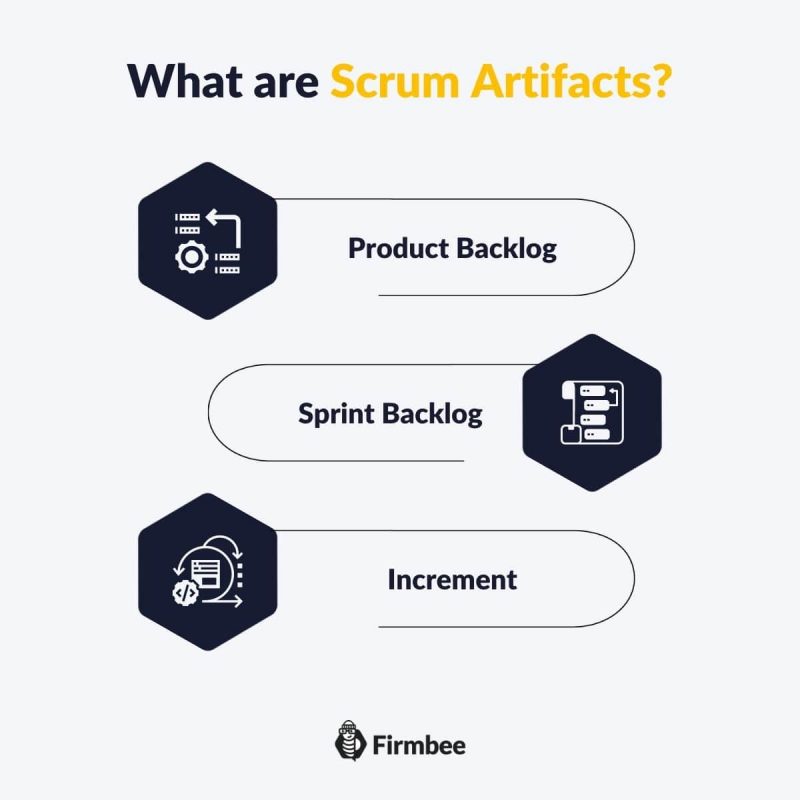In today’s article, we will focus on the Scrum Artifacts. We will explain Product Backlog, Sprint Backlog, and Increment. We’ll also answer the question of what Scrum Team members and Stakeholders use them for.
Scrum artifacts – table of contents:
What are Scrum Artifacts?
Three Scrum Artifacts are crucial for an effective Scrum Team. These are two Backlogs, which are lists of tasks, and the Increment, which is a potentially release-ready version of a Product improved in a given Sprint.
They are collectively called Artifacts because they have one purpose. Namely, to maximize the transparency of information regarding the work on the Product.
With the availability of Scrum Artifacts, any Scrum Team member or Stakeholder can get a clear picture at any time. There, they will see:
- What Product and for what Purpose is being created
- What tasks are planned to be performed
- What tasks the Development Team is currently working on
- What tasks have already been completed
- What the current version of the running Product looks like
Scrum backlogs describe the Product both from the technical and business angles. The technical description of the Product created by the Scrum Team contains the way the Product works, as well as proposals of specific solutions to be implemented by the Development Team. The business description contains User Stories that answer questions like:
- What is the Product for?
- What functions does the Product have to perform?
- What expectations of the Customer should the Product meet?
Thus, they describe partial functionalities of the Product from the Customer’s point of view.
We will devote separate posts to each Scrum Artifact, dedicated to Product Backlog, Sprint Backlog, and Increment, respectively.

Product Backlog
The Product Backlog is a list of tasks that the Scrum Team will work on. It is expressed in business language, and its scope covers the entire duration of the project.
The maintenance and availability of the Product Backlog are crucial for the transparency of the Scrum Team’s work. Thanks to this document, the Development Team knows what business problem they are working on solving and what the Customer’s priorities are. What’s more, the Product Backlog is a signpost on which you can support yourself when you get overwhelmed with smaller tasks that blur the picture of the whole project.
The Product Backlog keeps track of the Development Team’s progress toward the Product Goal. It is managed by the Product Owner and should be updated regularly. So that at any time it gives a clear picture of the work that needs to be done.
The tasks with the closest deadlines are described in the Product Backlog in the most detailed way. Tasks with longer deadlines or optional tasks have a form of a general outline.
Sprint Backlog
We can think of Sprint Backlog as similar to Product Backlog. However, the way tasks are described and the time scale changes.
While in the Product Backlog the focus was on describing tasks from a Stakeholder and business language perspective, the Sprint Backlog is the domain of Developers. They are responsible for maintaining and updating the Sprint Backlog. It is a description of the Team’s work, therefore it is expressed in technical language. It describes detailed tasks and solutions as the Developers plan their execution.
The Sprint Backlog operates on a time scale that corresponds to the duration of one Sprint, typically two weeks to one month. It allows for tracking of the Development Team’s progress toward the Sprint Goal.

Increment
Product Backlog content is a step-by-step description of how to achieve the Product Goal. The content of the Sprint Backlog is a description of the tasks leading to the achievement of the Sprint Goal. The Increment is the sum of partial Product functionalities realized in a given Sprint added to the current state of the Product.
Each new Increment builds on the previous one. Therefore, the work done should be thoroughly tested. Testing allows you to make sure that the new solution does not interfere with or disrupt those that were created earlier. For the work to become an Increment, it must be integrated into the existing state of the Product. And result in its improved, working version.
In other words, an Increment is a set of tasks completed in one Sprint that make up a new, working version of a Product. And its business meaning is described by the Definition of Completion. It is entered into the Product Backlog during Sprint Planning.
Summary
The Scrum artifacts are the Product Backlog, Sprint Backlog, and Increment. They provide all stakeholders with access to information about the status of the Product. Scrum artifacts contain Scrum Team Goals and Objectives defined from the business and technical angles. Additionally, they contain all the characteristics of the current, working version of the Product, potentially ready to be released to the market.
If you like our content, join our busy bees community on Facebook, Twitter, LinkedIn, Instagram, YouTube, Pinterest.
Author: Caroline Becker
As a Project Manager, Caroline is an expert in finding new methods to design the best workflows and optimize processes. Her organizational skills and ability to work under time pressure make her the best person to turn complicated projects into reality.
Scrum Guide:
- Glossary of basic terms, roles and notions
- What is Scrum?
- Scrum values
- How to implement Scrum in your company?
- Scrum Team - what is it and how does it work?
- Who is a Product Owner?
- The most common mistakes of Product Owner
- Who is the Scrum Master?
- Characteristics of a good Scrum Master
- The most common mistakes of Scrum Master
- What statistics and metrics should the Scrum Master track?
- Cooperation between Product Owner and Scrum Master
- Development Team in Scrum
- The most common mistakes of Developers
- Scrum artifacts
- Scaling Scrum
- Sprint Backlog
- What is the Product Backlog?
- What are User Stories?
- Creating the best User Story with INVEST
- The most common User Story mistakes
- User Story Acceptance Criteria
- Estimation and Story Points in Scrum
- Planning Poker
- Team Estimation Game
- Defining Increment
- Scrum events
- What is Sprint in Scrum?
- Scrum Team Commitments - Product Goal, Sprint Goal and Definition of Completion
- What is a Burndown Chart?
- How to create and interpret a burndown chart?
- Advantages and disadvantages of the burndown chart
- Kanban boards in Scrum and Scrumban
- Velocity in Scrum - Speed of the Development Team
- Daily Scrum
- Sprint Planning
- Sprint Review
- What is a Sprint Retrospective?
- Common mistakes during a Sprint Retrospective
- Product Backlog nurturing


















